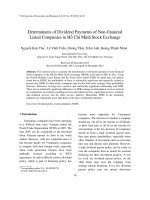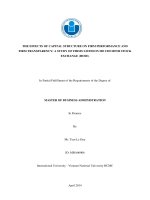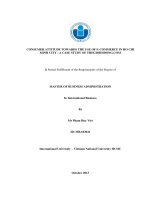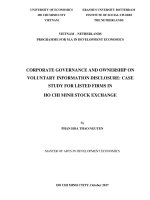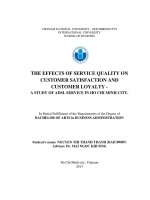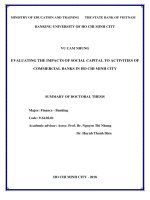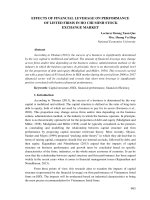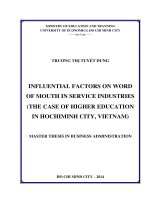The effects of capital structure on firm performance and firm transparency a study of firms listed in ho chi minh stock exchange (hose)
Bạn đang xem bản rút gọn của tài liệu. Xem và tải ngay bản đầy đủ của tài liệu tại đây (903.09 KB, 72 trang )
THE EFFECTS OF CAPITAL STRUCTURE ON FIRM PERFORMANCE AND
FIRM TRANSPARENCY: A STUDY OF FIRMS LISTED IN HO CHI MINH STOCK
EXCHANGE (HOSE)
In Partial Fulfillment of the Requirements of the Degree of
MASTER OF BUSINESS ADMINISTRATION
In Finance
By
Mr. Tran Le Duy
ID: MBA06006
International University - Vietnam National University HCMC
April 2014
EFFECTS OF CAPITAL STRUCTURE ON FIRM PERFORMANCE AND FIRM
TRANSPARENCY: A STUDY OF VIETNAMESE ON-GOING FIRMS LISTED IN
HO CHI MINH STOCK EXCHANGE (HOSE)
In Partial Fulfillment of the Requirements of the Degree of
MASTER OF BUSINESS ADMINISTRATION
In Finance
by
Mr. Tran Le Duy
ID: MBA06006
International University - Vietnam National University HCMC
April 2014
Under the guidance and approval of the committee, and approved by all its members, this
thesis has been accepted in partial fulfillment of the requirements for the degree.
Approved:
---------------------------------------------Chairperson
--------------------------------------------Committee member
---------------------------------------------Committee member
--------------------------------------------Committee member
---------------------------------------------Committee member
--------------------------------------------Committee member
Acknowledge
To complete this thesis, I have been benefited from the following people:
First of all, I would like to express my deepest gratitude to my advisor, Dr. Le Vinh
Trien, for all his support and guidance without that I could have not been able to complete
this thesis. I also wish to extend my sincere thanks to the lecturers of the Master of Business
Administration program at International University for their passionate sharing and the
members of the Examination Committee for taking time and giving valuable comments to
improve this study.
I would like to thank my friends and classmates at MBA06 for having been beside me
over the past two years of the program. I would also express my gratitude to my managers
and colleagues in Treasury Division – Mekong Hosing Bank H.O for facilitating and
supporting me during thesis time.
Last but not least, I dedicate this work to my parents and my brother for their
unceasing encouragement and endless support. My special thanks to my wife who has always
been my source of joy and love in life during the good and hard times.
Ho Chi Minh City, April 2014
Tran Le Duy
-i-
- ii -
Plagiarism Statements
I would like to declare that, apart from the acknowledged references, this
thesis either does not use language, ideas, or other original material from anyone; or
has not been previously submitted to any other educational and research programs or
institutions. I fully understand that any writings in this thesis contradicted to the above
statement will automatically lead to the rejection from the MBA program at the
International University – Vietnam National University Ho Chi Minh City.
-1-
Copyright Statement
This copy of the thesis has been supplied on condition that anyone who
consults it is understood to recognize that its copyright rests with its author and that
no quotation from the thesis and no information derived from it may be published
without the author‟s prior consent.
© Tran Le Duy/ MBA06006/ 2012-2014
-2-
Table of Contents
CHAPTER 1 - INTRODUCTION .............................................................................. 6
1. Background ......................................................................................................... 6
2. Problem statement ............................................................................................... 8
3. Research Question ............................................................................................ 11
4. Research Objectives .......................................................................................... 11
5. Research Methodology ..................................................................................... 12
6. Limitation and scope of the research ................................................................ 13
7. Research Significant ......................................................................................... 14
8. Research structure ............................................................................................. 14
CHAPTER 2 – LITERATURE REVIEW ............................................................... 16
1. Traditional capital structure theories ................................................................ 16
1.1.
Trade-off theory.........................................................................................17
1.2.
Pecking order theory..................................................................................17
1.3.
Agency cost ...............................................................................................18
2. Previous studies related to capital structure ...................................................... 18
2.1.
Positive relationship between capital structure and firm performance ......18
2.2.
Negative relationship between capital structure and firm performance ....19
2.3.
Mixed results of capital structure and firm performance ..........................20
3. Role of financial transparency .......................................................................... 20
4. Econometric model and Hypotheses of the study ............................................. 21
4.1.
Variables of the study ................................................................................21
4.1.1. Performance variables ...............................................................................21
4.1.2. Independent variables ................................................................................22
4.2.
Hypotheses of the study.............................................................................23
-3-
4.3.
Econometric model ....................................................................................23
CHAPTER 3 – DATA AND METHODOLOGY .................................................... 25
1. Data ................................................................................................................... 25
2. Model and Variables ......................................................................................... 26
3. Research method ............................................................................................... 27
3.1.
Descriptive Statistics .................................................................................28
3.2.
Correlation Analysis ..................................................................................28
3.3.
Regression Analysis ..................................................................................29
CHAPTER 4 – FINDINGS AND DISCUSSION .................................................... 30
1. Descriptive statistics ......................................................................................... 30
1.1.
Descriptive statistics for the whole data set ...............................................30
1.2.
Descriptive statistics per industries ...........................................................31
1.3.
General look of year by year .....................................................................33
2. Correlation statistics.......................................................................................... 34
3. OLS regression analysis .................................................................................... 36
CHAPTER 5 – CONCLUSION ................................................................................ 40
1. Summary ........................................................................................................... 40
2. Implications....................................................................................................... 43
3. Limitations and further researches .................................................................... 45
References ................................................................................................................... 47
Appendix ..................................................................................................................... 51
-4-
-5-
CHAPTER 1 - INTRODUCTION
1. Background
Firm‟s investment resources were financing basically from internal resources
which include common stock, prefer stock and retain earnings in generally called
equity capital. External resources consist of short and long-term debts and bonds
issuance. For financial or non-financial firms, choosing an optimal proportion
between debt and equity financing is one of the most important financial decisions.
Adjusting a reasonable proportion of debt can help the firm reduce an overall cost of
capital, take advantage of tax shield, obtain benefits of financial leverage and also
increase the firm value.
In 1958, theory of capital structure originated by Modigliani and Miller said
that under the perfect capital market, assumption no bankrupt cost, without taxes, the
firm‟s value is independent with the structure of the capital. However, in 1963,
considering corporate tax, Modigliani and Miller modified their conclusion that under
a perfect capital condition, with tax-deductible interest payments, firm value and
capital structure are positively related. Other theories such as the trade-off theory
(Myers, 1984), pecking other theory (Myers and Majluf, 1984) and the agency cost
theory (Jensen and Meckling, 1976) support for the relevance of capital decision to
firm value in imperfection which exists bankruptcy cost, agency cost, tax shield,
information asymmetry, etc… in the real world. As a result, the firm should maximize
its value by examining its capital structure or financial leverage decisions from its
impact on the firm.
-6-
Corporate transparency and information disclosure are important elements of
corporate governance, investors‟ confidence and investment flows. The firms that do
not adopt good transparency and information disclosure policies may suffer agency
costs, defined as the value reduction in welfare experienced by the shareholders. It is
more likely that in a firm where a weak transparency and disclosure policy is
practiced, managers may use their information advantage to pursue their self-interests
(Chen, Chung, Lee and Liao, 2007). Therefore, firms are able to control and reduce
the agency costs by increasing corporate transparency; might also be able to increase
the shareholders‟ value, the goal of financial management. In addition, firm financial
transparency is very importance channel for access to external financing since it
provides to investors and shareholders generally whole firm‟s financial activities.
However, in prior literatures argued and found evidence suggesting that the usefulness
of financial information is reduced in private firms compared with public firms (Ball
and Shivakumar 2005; Burgstahler et al. 2006).
Vietnam joined the WTO on 7 November 2006, and was recognized as an
official member of this organization on 11 January 2007. Joining the WTO has
opened up great opportunities for goods and services in Vietnam with vast market,
including 155 member countries, accounting for 97% of global GDP. After 5 years of
joining the WTO, Vietnam's economy has grown strongly in all fields, particularly in
the field of trade and services. However, after WTO accession country was faced with
the problems. The biggest challenge is the increasing competitive pressures, including
on the domestic market due to our country should take steps to open their markets to
foreign firms. At the same time, so was connected with the international market to the
volatility of world impacts on Vietnam faster and stronger. The enterprises from
-7-
Vietnam should have some preparation steps such as restructuring firm, increasing
cooperate governance, recapitalization and even acquisition. Vietnamese enterprises
in this integration time need to recapitalize in order to enhance corporate performance
by utilizing effectively financing resource in positive financial investment projects.
2. Problem statement
The capital structure referred to firm is a mixture of debt and equity in longterm capital which firm mobilizes to finance investment projects. The most reason
that firm chooses debt financing is tax-deductible interest payments. Corporations
take advantage of tax shield when they finance their investment projects by using debt.
In addition, accessing to loans is more reachable than equity because cost of equity is
more expensive than cost of debt. Consequently, creditors have more priority than
shareholders when the company in bankruptcy situation. However, equity is needed in
case corporation wants to increase their level of equity compare with debt in order to
remain the health financial status of company. Corporations in different industries
have different capital structure. Proportion between debt and equity differently
depends on characteristics and goals of company. Since then, each company forms
theirs optimal capital structure. The optimal capital structure is the one which offers
ideally balance debt-equity ratio and minimize cost of capital, and in generally,
increase firm value.
In fact, debt financing is really profitable when the company uses it effectively
in their investments and creates profit more than interest payments. Because when
level of debt financing reaches to some points that will be arising other costs. It also
influences firm‟s investments and accordingly decreases firm value. Aggarwal and
-8-
Kyaw (2006) pointed out that debt can have both positive and negative effects on firm
value so that balancing the agency cost and other costs of debts is to determine the
optimal debt structure. Particularly, when firms have a huge amount of cash flows,
debts would force financial managers more riskily in negative net present value
projects, while firms with outstanding debts may not strongly invest even if some
projects have positive net present value. Therefore, arguments of Jensen (1986), Stulz
(1988) and Myers (1993) sent a message that debt has both effects on firm value
depending upon firm‟s future investment opportunities.
In addition, McConnell and Servas (1995) did a very interesting investigation
of the relationship between firm values, leverage and owners‟ equity of US firms.
They discovered that firms with high growth or high P/E ratios have the value
negatively related to leverage, and vice versa to ones with low growth or low P/E
ratios. Their evidences support that in low-growth firms, leverage play a role as a
monitoring mechanism to enhance firm value, and in high-growth firms may cause
under investments and drive down firm value.
In particular, Easterbrook (1984) pointed out that firms which are forced to
pay out a higher fraction of their cash flow are subject to greater scrutiny because of
their need to access external capital and argues that this greater scrutiny benefits firms
by reducing agency problems between shareholders and managers. In addition, since
more transparent firms are likely to be more efficiently priced, they are also likely to
make better investment choices, which make them more valuable on average. As a
result, the firm benefits when favorable information is generated and is hurt when
unfavorable information is generated. We show that the cost associated with
-9-
unfavorable information exceeds the benefit associated with favorable information,
thus transparency is costly and firms will tend to choose lower leverage ratios.
In Vietnamese corporations, determining an optimal capital structure and
taking advantage of financial leverage is really not effective. When the Government
implements the contradictory monetary policy due to inflation increase, accessing
loans at this point is very difficult but not impossible. Besides, joining to the World
Trade Organization (WTO), Vietnamese corporations are facing highly competitive
pressures from foreigner corporations so that they have to recapitalize, improve
corporate governance, and participate in M&A activities to restructure the firm. Along
with recapitalization activities, Vietnamese enterprises would pay more attentions on
financial disclosure and transparency. Financial information helps external capital
providers a general look about financial activities of company. Thus, firm‟s
achievements in the past and the incoming tactical investment projects will attract
investors.
In addition, Vietnam and other 11 countries are negotiating to participate in
Trans-Pacific Partnership agreement (also called TPP). According to a recent statistics
published by General Statistics Office (GSO), the proportion of Vietnam‟s export to
TPP members in 2013 accounted for 39% and import from TPP members was 22% of
total imports of Vietnam. Vietnam‟s exports about of 1% of total imports of the TPP
member countries. This demonstrates that TPP is a potential market for Vietnam so
that capitalization for enhancing the corporate value in significantly needed in the
next periods. It also means capital structure decision is very importance for increasing
firm‟s performance.
- 10 -
3. Research Question
The main objective of this thesis is to investigate the effect of capital structure on
firm performance of on-going firms listed in Ho Chi Minh Stock Exchange (HOSE),
Vietnam based on a thorough financial statements which officially public in website
of HOSE. In addition, the study investigates if there is any relationship between
capital structure and financial disclosure and transparency as well as between
financial disclosure and performance. The research is covered by the following main
research questions:
What is the effect of capital structure on firm performance?
What is the relationship between capital structure and firm‟s financial
disclosure and transparency?
Is there a relationship between firm financial transparency index and firm
performance?
4. Research Objectives
Generally, this thesis is an empirical study of effects of capital structure on firm
value of on-going firms (financial firms exclusive) listed in HOSE during the recent
economic downturn period (2008-2012). This timeframe is chosen according to
accession time when Vietnam officially joins into WTO. That time is also easy for
researchers to obtain the changes in capital structure then consequently impacts in
firm value.
The specific objectives of this study were:
-
To describe the current status and structure of on-going firms‟ capital
listed in HOSE and the relationship between capital structure and firm
performance
- 11 -
-
To examine the relationship between firm‟s capital structure and firm‟s
financial disclosure and transparency
-
To investigate whether the firm‟s financial transparency index has impact
on firm performance
5. Research Methodology
The research employs empirical study and uses quantitative method. Firm year
data are collected from the financial statements which presented annually in HOSE
companies‟ website or could be found on financial website such as www.vcbs.com,
www.cophieu68.com, www.fpts.com.vn, etc. Firstly, the collected samples are
described by descriptive statistics in order to bring the overview of the sample data. In
the next steps, Pearson correlation analysis is conducted to check the correlation
between variables in the model. Finally, regression analysis is carried out to explore if
there is a significant relationship between capital structure and firm performance, and
correlation between firm‟s capital structure and firm‟s financial disclosure and
transparency. EVIEW 8.0 software is used for regression analysis.
- 12 -
6. Limitation and scope of the research
In this study, the valuations of non-financial firms listed in Ho Chi Minh stock
Exchange (HOSE) are assessed. Data will be collected from annual reports of listed
companies during period of 2008-2012. The research mainly focuses on financial
statements of firm-year observations for the chosen timeframe. In additional, the
transparency index of listed firm on HOSE may be collected from the most recent
year, year of 2012.
For collecting the desired samples, the following criteria are considered:
-
To ensure the thoroughness of study and the transparency of the data,
companies must be listed in HOSE before the year of 2008 and must have
uninterrupted operation during the timeframe of study 2008-2012.
-
Firms operating in banking, financial and investment services firms are
excluded from the sample set. This can be explained that banks and
financial and investment service firms, in fact, have special nature of
financial statements differently from other firms, thus an inclusion of
banks and financial service firms in this study would potentially create
misleading results of this research.
-
For the purpose of ensuring the coherence of data and under time pressure
of this study, firms that do not have fiscal year ending on 31 December
will be excluded from the sample.
-
Firms with missing annual reports for some year or some data missing in
report also will be excluded from the sample
- 13 -
7. Research Significant
The research focuses on bringing an overview of current capital structure of nonfinancial firms listed in HOSE during turndown economic period. A value in this
research is that exploring the research topic for updated data in 2008-2012, while
most studies conducted before this timeframe, financial crisis. The relationship
between capital structure and financial disclosure and transparency will be a new look
of effectiveness of capital structure. The research findings are expected to contribute
to financial managers of Vietnamese firms in HOSE some evidences of the impacts of
capital structure to firm performance and firm‟s financial transparency. According to
results of this empirical study, the managers can use as reference for capital structure
decisions in their own particular business; and choose approximately for sharing
firm‟s information to shareholders and investors in efficient way in order to attract
external capital investment. Lastly, the research also contributes to current study
source for determinants of firm performance in view of capital structure in Vietnam.
8. Research structure
The thesis covers five chapters as follows:
Chapter 1 – Introduction: This chapter provides an overview of the research
such as research topic, objectives of the research, methodology employed,
scope of study, and the significance of research.
Chapter 2 – Literature Review: In this chapter, relevant literature on working
capital management and different arguments on the relationship between
working capital and firm‟s performance are summarized. Previous studies are
mentioned and a link to current background of the research issue is introduced.
- 14 -
These literatures set the base and rationale for hypothesis and research model
formulation at the end of this chapter.
Chapter 3 – Data and Methodology: This section explained in detail the
selection of data source, variables, model and methodology that are used in the
research.
Chapter 4 - Results and Discussions: Results from descriptive statistics and
regression analysis of data collected are presented and discussed in this section.
Chapter 5 - Conclusion: This chapter summaries the research findings and
give conclusions on the research topic. Implications of research results as well
as their limitations and further recommendations for research are also
mentioned in this chapter.
- 15 -
CHAPTER 2 – LITERATURE REVIEW
In this chapter, the important theories and studies that are relevant to our study
on the research topic are discussed. The writer makes an effort to give a connection of
these discussions to the current context of Vietnam to provide a more thorough and
practical view on the topic.
First we look at some traditional capital structure theories such as MM
theorem by Modigliani and Miller 1958, trade-off theory (Myers, 1984), pecking
order theory (Myers and Mailuf, 1984), and Agency cost (Jensen and Meckling, 1976),
etc… are discussed about the relationship between firm value and capital structure.
Later on, findings of previous studies are presented and summarized. After checking
on the current condition of the local market, the paper suggests a research model on
the relationship between capital structure and firm performance with the purpose to
validate conclusions of previous authors in the context of Vietnam market.
1. Traditional capital structure theories
After the research process around the tile of articles, there are little studies take
this subject, whereas the most studies focus on the determinants of capital structure or
determining optimal capital structure. The roots of capital structure theory refer to
more than fifty decades since the seminal work in which presented by Modigliani and
Miller 1958 (thereafter called MM theorem). They proved under the perfection capital
market assumption that no taxes, bankruptcy and transaction costs that cost of capital
dose not effect on capital structure, since then debt irrelevantly has no impacts on firm
value. In other words, the value of levered firm equals to the value of unlevered firm.
- 16 -
In 1963, Modigliani and Miller fixed their previous paper, argue that, assumption
of existing taxes, borrowing give tax advantage, where the interest payment deducted
from tax and it will result tax shield which in turn reduce cost borrowing and then
maximize the firm performance (Miller, 1977). This means that the firm‟s value
increase as debts increases.
1.1.
Trade-off theory
Myers (1984) considers a contest between two perspectives on corporate debt. He
calls one of these hypotheses is the trade-off theory, which states that firms balance
tax savings from debt against deadweight. In general, the trade-off theory of capital
structure refers to the idea that a company chooses how much debt finance and how
much equity finance to use by balancing the costs and benefits. It states that there is
an advantage to financing with debt, the tax benefits of debt and there is a cost of
financing with debt, the costs of financial distress including bankruptcy costs of debt
and non-bankruptcy costs. The marginal benefit of further increases in debt declines
as debt increases, while the marginal cost increases, so that a firm that is optimizing
its overall value will focus on this trade-off when choosing how much debt and equity
to use for financing.
1.2.
Pecking order theory
In addition, the pecking order theory of Myers and Majluf (1984) stated that, due
to adverse selection, firms look to retain earnings, then to debts, and only in extreme
situation to equity for financing. Firms prioritize their sources of financing, first
- 17 -
preferring internal financing, and then debt, lastly raising equity as a “last resort”.
Hence: internal financing is used first, when internal fund using for investments is
completely depleted, debt should be preferred to equity because of the low transaction
cost, tax benefits and other advantages attached to it. The proper mixture of debt and
equity use in firm will increase the firm value.
1.3.
Agency cost
More recently, there has been a movement form the traditional tax-bankruptcy
cost argument towards a consideration of the agency cost in which indicates potential
conflict between shareholders and managers. The conflict arises when the
shareholders choose the managers as agent of their salves to manage the firm in order
to maximize their wealth. However the managers firstly concentrate on the high
profitable and risky projects to achieve their interests that presented incentives and
rewards, after that concerning of shareholder benefits, all of these lead to maximize
the firm value (Jensen and Meckling (1976), Harri and Raviv (1991) and Myers
(2001)).
2. Previous studies related to capital structure
2.1. Positive relationship between capital structure and firm performance
Holz (2002) found that capital structure related positively to the firm performance,
the result ascribes to the willing of firm‟s managers to finance their projects by
borrowing and using debts to optimally maximize the performance. According to this
result, the bank shall examine the feasibility of firm‟s projects before offer the loans
until the firms can achieve required returns to meet their obligations. On the same
- 18 -
manner, Roberta and Donald (2003) found that financial leverage influences to the
expected performance, they explained that low growth firms attempt to depend on the
borrowing money for utilizing and investing at the profitable projects, therefore it will
increase the firm performance. Margaritis and Psillaki (2010) also proved that
financial leverage correlated positively and significantly to firm performance.
2.2. Negative relationship between capital structure and firm performance
In contrast to the above, there are most of the studies had proved that capital
structure related negatively with firm performance. Majumdar and Chhibber (1999)
stated that level of debt associated inversely with firm performance. The creditors
who are using the loans as disciplinary tool which bases on the restrictions that
impose to prevent firm distribute earnings on the shareholders or impose sufficient
collaterals on loans. Since then, these restrictions will lead firm adversely on the
performance. Abor (2005) also noted that various capital structure measurement
which represented short-term debt, long-term debt and total debt associated negatively
with firm performance. Moreover, Rao, Hamed, Al-yahee and Syed (2007) stated that
capital structure related inversely on firm performance on Oman firms. The
relationship refers to high borrowing cost and to the weakness of debt market in
Oman economy. They suggested that tax savings as a result of using debts are not
sufficient to meet cost of debts. Krishnan and Moyer (1997), Gleason, Simerly and Li
(2000), King and Santor (2008) and Onalapo and Kajola (2010) proved that capital
structure also related negatively with the firm performance.
- 19 -
2.3. Mixed results of capital structure and firm performance
Weill (2008) investigated the effect of financial leverage on firm performance in
seven European countries. The empirical study summarize that financial leverage
related positively and significantly on firm performance in Italy and Spain, whereas
negatively and significantly in Germany, France, Belgium and Norway, but
insignificantly in Portugal. Cheng, Liu and Chien (2010) used threshold regression
model on 650 Chinese firms (2001-2006). The results revealed that debt ratio and firm
value positively when debt ratio between 53.97% and 70.48%, while debt ratio more
than 70.48% negatively relationship. Eventually, Li Weng, Wang and Zhou (2008)
proved that financial leverage related negatively with return on asset, but positively
with return on equity.
3. Role of financial transparency
Rajan and Zingales (1998) argued that financial market imperfections have an
impact on development and growth. Financial transparency helps alleviate market
imperfections in several ways. First, high quality information can help managers
identify good projects or investment opportunities. Second, financial transparency
helps corporate control mechanisms in preventing managers from expropriating
wealth from investors or creditors (Fama and Jensen 1983). Third, financial
transparency can impact economic performance by reducing adverse selection,
liquidity risk, and information risk (Diamond and Verrecchia 1991; Leuz and
Verrecchia 2000; Easley and O‟Hara 2004).
- 20 -
